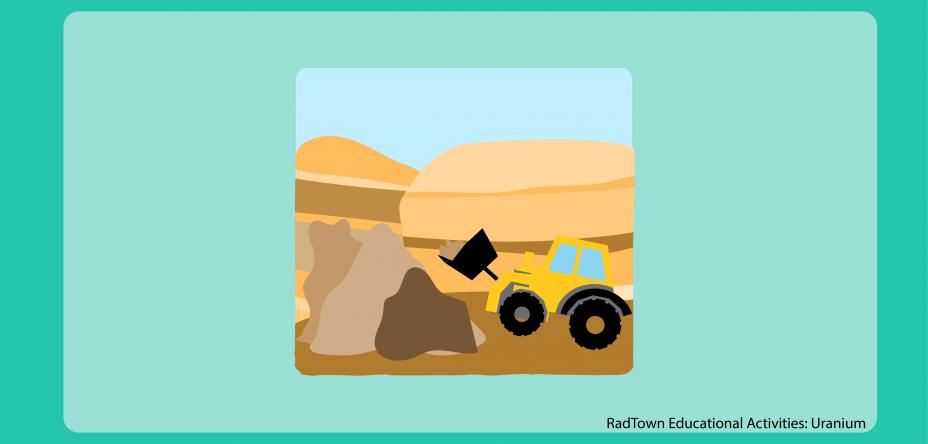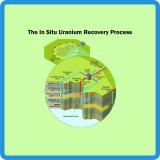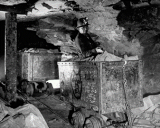RadTown Uranium: Teacher Information
Historically, uranium was used as a coloring agent in decorative glass and ceramics. From the late 1940s to 1970s, the United States experienced a uranium mining and milling boom driven by the demand for nuclear weapons and nuclear power. Along with the mining and milling boom, scientists were testing nuclear weapons and conducting environmental studies with radioactive waste. These activities have disproportionately impacted Native Americans, Alaska Natives and their lands.
Today, the greatest use of uranium continues to be for power generation. Uranium is also used in industrial and research processes. Uranium mining and milling continues today in the U.S., but on a small scale.
- Background Information for Teachers
- Target Audience and Activity Topics
- Activity Times
- Next Generation Science Standards
- Common Core State Standards
- Additional Resources
Background Information for Teachers
Uranium is a trace element commonly found in rocks, soil, water, plants and animals. Geologically, uranium is generally found in sandstone deposits, with some found in volcanic remnants (for example, breccia deposits of the Grand Canyon). The main U.S. sandstone deposits of uranium are in the Colorado Plateau, Northern Arizona, the Wyoming Basin, the Texas Coastal Plain and Nebraska. The largest single source of uranium ore in the U.S. is the Colorado Plateau located in the Four Corners intersection of Colorado, Utah, New Mexico and Arizona.
Uranium Mining and Milling
The U.S. mining industry extracts (removes) uranium from the ground through several methods:
- Physically removing the rock ore through open-pit mining or underground mining.
- Open-pit mining involves stripping away or excavating the topsoil and rock that lie above the uranium ore.
- Underground mining involves extracting rock through a tunnel or opening in the side of a hill or mountain, or digging a shaft from the surface into the underlying ore zone.
- Chemically dissolving the uranium out of the rock ore is done through either heap leaching or in-situ leaching.
- Heap leaching (not presently used in the U.S.) is the process of sprinkling chemicals on above-ground piles of crushed ore-bearing rock in a lined pit and collecting uranium through underground drains. Either acid or alkaline solutions may be used to remove uranium from the host ore rock.
- In-situ leaching (presently the most common method used in the U.S.) involves drilling wells deep underground and using chemicals (typically alkaline and include sodium bicarbonate and oxygen mixed with water) to dissolve the uranium before it is pumped to the surface as a liquid through wells.
Milling is the process that removes uranium from the ore. The ore is crushed and ground up, treated with chemical solutions to dissolve the uranium, and separated from the solution. The final, dried uranium product is commonly called “yellowcake.”
Benefits and Impacts
Source: U.S. Geological Survey
The uranium mining boom began with the U.S. Atomic Energy Commission buying and stockpiling uranium for nuclear power and weapons development. Today, uranium is used as fuel for nuclear power generation, for industrial purposes, and in manufacturing and research.
Radium, thorium and other radioactive elements are mined with uranium and are found in the tailings. Radium was historically used for medicine and in consumer products like hair tonic, toothpaste, ointments, elixirs and glow in the dark watches and clock faces. Today, radium is only used in research.
During the boom, uranium mines provided economic advantages for tribal communities including jobs, development of new roads and airstrips for airports, and money spent by non-tribal workers for food, lodging and other services. However, tribal communities are facing many environmental and public health concerns. The Navajo Nation has more than 500 abandoned uranium mines, four inactive uranium milling sites and a former dump site that have not been properly cleaned up. The lasting impacts of these sites have led the Navajo Nation to ban uranium mining and exploration on its lands. Most of the world’s production of uranium today comes from mines in Kazakhstan, Canada and Australia. In 2012, six underground mines and five in-situ leaching operations were in operation within the U.S. As of 2014, five in-situ leaching sites were in operations and two conventional mills were in standby (not in operation).
Radiation Exposure
Radioactive dust and high levels of radon in abandoned mine, milling sites and former dump and testing sites makes these areas unsafe. Radioactive materials that are not properly cleaned up can be spread by wind and water runoff, affecting surrounding areas, humans and animals. Structures built close to abandoned uranium mines, or with contaminated materials from mining areas, are at risk of having elevated radiation and radon levels.
Ionizing radiation, emitted (given off) from these radioactive elements, can damage living tissue by changing cell structure and damaging DNA. The amount of damage depends on the type of radiation, the exposure pathway, the radiation’s energy, the rate which the energy is absorbed (dose rate) and the total amount of radiation absorbed.
Children are more sensitive to ionizing radiation than adults because children are still in the process of growing. There are more cells dividing and a greater opportunity for radiation to disrupt the growth process. The U.S. Environmental Protection Agency’s (EPA) radiation protection standards take into account the differences in sensitivity due to age and gender.
Radiation Protection
People should NEVER:
- Enter an abandoned mine, or herd livestock in them.
- Disturb abandoned mine, mill, dump or test sites.
- Handle, dispose or re-use abandoned equipment at these sites.
- Swim or drink water from open pit mine lakes.
- Drink the water from streams and springs near these sites.
- Remove rock or soil from these sites or use materials from the sites for building construction.
People living near former uranium mines, mills and dump and testing sites can contact their local or state geological survey office or bureau of health to determine if they are at risk due to increased levels of radiation in the area where they live.
Basic radiation protection concepts can be applied separately or in combination to help limit people’s exposure to increased radiation levels:
- Time: limiting time near the radiation source.
- Distance: increasing the distance from a radiation source.
- Shielding: placing material or a barrier between a person and a radiation source.
Highlights in Uranium History
| Dates | Historical Events |
|---|---|
| 1400s | Uranium was mined to create a red-orange color in ceramics. |
| 1789 | Martin Klaproth, a German chemist, discovered uranium and named it after the planet Uranus. |
| 1871 | The first radium/uranium ore was discovered in the U.S. in gold mines near Central City, Colorado. |
| 1896 | Henri Antoine Becquerel discovered that uranium is radioactive. |
| 1938 | Otto Hahn and Fritz Strassman discovered that uranium could be split to release energy (fission). |
| 1939 | World War II begins. |
| 1942 to 1946 | The Manhattan Project was led by the U.S. and supported by the United Kingdom and Canada. The project researched and developed the first atomic bombs during World War II. |
| 1945 | The first atomic bomb is tested in New Mexico before the bombing of Japan in Hiroshima and Nagasaki during the final stages of World War II. |
| 1945 to 1991 | The Cold War as a long period of tension and distrust between democratic and communist countries. During this period, the U.S. and the Soviet Union (viewed as superpowers) raced to develop stockpiles of nuclear weapons. |
| 1945 to 1992 | Nuclear testing took place in the U.S. and around the world in attempts to find peaceful uses for atomic energy. |
| 1946 | The Atomic Energy Act was signed to regulate civilian and military use of nuclear materials and promote atomic energy development for safe and peaceful use. |
| 1947 | Uranium mining and milling boom began in the U.S. Before World War II, the U.S. purchased uranium from other countries or got it from vanadium deposits in Utah and Colorado on the Colorado Plateau. During the boom, mine operators extracted nearly 4 million tons of uranium ore from the Navajo Nation alone. Uranium mining also took place in the Lakota lands in the Black Hills of South Dakota, the Spokane reservation in Washington, and the Tohono O’odham Nation, west of Tucson, Arizona. The boom continued until the early 1970s. |
| 1949 to 1956 | Colorado and the U.S. Public Health Service began a study of radiation safety in uranium mines and mills. They conducted environmental studies of the mines and epidemiological studies of the miners. The mine studies concluded in 1956, but the epidemiological study continued. |
| 1959 | Miners are provided with a U.S. Public Health Service pamphlet warning them of possible radon exposure while working in the mines. This is the first government-issued document addressing the possible health risks to the miners from working in the mines. The pamphlet was not widely distributed and some mine operators downplayed the possible radon exposure. |
| 1960 | The U.S. Public Health Service released a report to the mining states highlighting the link between uranium mining and lung cancer. However, the federal government continued to defer to the states for the creation and enforcement of safety measures in mines that were not Atomic Energy Commission property. |
| 1965 | Utah, Colorado and New Mexico study pollution from uranium mills and discover twenty miles of the Animas River devoid of life downstream from Durango, CO mill. New Mexico and Colorado pass regulations requiring maintenance of abandoned uranium mill tailings piles and outlawing direct discharges to rivers. Industry largely ignored the rules. |
| 1967 | The U.S. Secretary of Labor announced a federal standard for radon and its daughters in uranium mines supplying the federal government. |
| 1970 to present | Uranium mining and milling decreased greatly after the Atomic Energy Commission no longer needed to purchase uranium. The demand for uranium started to exceed the worldwide supply in the mid- to late-2000s. |
| 1978 | The Uranium Mill Tailings Radiation Control Act made the federal government liable for the pollution and required the cleanup of abandoned uranium mills, mill tailings, and homes built with contaminated mill tailings (waste containing radioactive elements like thorium, radium, polonium and radon). States contributed 10%, the federal government 90%. |
| 1979 | The Church Rock Spill occurred in New Mexico. Radioactive dust from uranium mining and milling was contained in a man-made lake. The dike broke and 93 million gallons of radioactive material (uranium, thorium, radium and polonium) flooded the land and went into the Rio Puerco. Animals died from drinking the contaminated water and people who came in contact with the water experienced burns. |
| 1979 | The Three Mile Island accident occurred when there was a partial nuclear meltdown in one of the two Three Mile Island nuclear reactors in Pennsylvania. |
| 1986 | An explosion and fire occurred at the Chernobyl Nuclear Power Plant in Ukraine. Radioactive particles were released into the atmosphere which spread over much of the western Soviet Union and Europe. |
| 1987 | The National Institute for Occupational Safety and Health (NIOSH) released a major study that recommended lowering the occupational radon dose for uranium miners from 4 WLM/year (approximately 5 rem per year) to 1 WLM/year. The recommendations were not followed and remain at 4 WLM/y today. |
| 1990 | Congress passed the Radiation Exposure Compensation Act (RECA). RECA represents an official government apology to victims of America’s Cold War nuclear program. RECA expressly acknowledges the U.S.’ failure to warn three groups of victims: uranium miners, on-site atomic test victims and downwind communities exposed to fallout from the atomic bomb tests. |
| 2005 | The Navajo Nation became the first indigenous government to ban uranium mining and exploration on its lands. |
| 2006 and 2007 | Congress, led by Henry Waxman (D-California, Chair of the Budget and Government Oversight Committee) sought direct testimony from Navajo officials and demanded a plan of action from the five federal agencies responsible for what Waxman described as a “40 year history of bipartisan failure and a modern American tragedy.” |
| 2008 to 2012 | Congress authorized a comprehensive 5-year plan to coordinate the cleanup of contaminated structures, soil and water in the Navajo Nation. The joint effort involves the EPA, Department of Energy, Nuclear Regulatory Commission, Bureau of Indian Affairs and the Indian Health Service. |
| 2011 | Japan’s Fukushima Daiichi nuclear disaster occurred when the nuclear power plant was hit by a tsunami that was triggered by an earthquake. |
Target Audience and Activity Topics
The RadTown Uranium activities are designed to teach middle and high school students about the significance of uranium and its decay products, such as radium and radon. Students will learn about the penetrating powers and effects of radiation and analyze the benefits and impacts of radiation exposure. Students will examine related radiation myths and facts and explore uranium and radiation-related science and engineering jobs. With a greater understanding of uranium and radiation, students can dispel myths and fears and be advocates for their community.
NOTE: The term “radiation” used in these activities generally refers to ionizing radiation, unless otherwise indicated.
Activity Times
All U.S. Environmental Protection Agency (EPA) Radiation Education Activities can be used individually or modified and combined to create multiple lessons. Activity options allow you to customize the activities to fit the time you have available (e.g., 1–2 class periods) and meet the needs and interests of your students.
The time needed to complete activities is between 45-60 minutes, not including optional activities or extensions.
Next Generation Science Standards
The concepts within these activity sets can be used to support the following science standards: •
- PS1. Structure and Properties of Matter
- PS4. Waves and Electromagnetic Radiation
- ESS3. Earth and Human Activity
Common Core State Standards (CCSS)
The concepts in the Vocabulary Activities align with the following
- CCSS English Language Arts Standards for Literacy in History/Social Studies, Science, & Technical Subjects:
- CCSS.ELA-LITERACY.RST.6-12.2 Key Ideas and Details
- CCSS.ELA-LITERACY.RST.6-12.4 Craft and Structure
- CCSS.ELA-LITERACY.L.6-12.6 Vocabulary Acquisition and Use
The concepts in the Uranium, Radium, and Radon activity align with the following
- CCSS English Language Arts Standards for Literacy in History/Social Studies, Science, & Technical Subjects:
- CCSS.ELA-LITERACY.SL.6-12.2 Comprehension and Collaboration
- CCSS.ELA-LITERACY.RST.6-12.7 Integration of Knowledge and Ideas
- CCSS.ELA-LITERACY.WHST.6-12.1 Text Types and Purposes
- CCSS.ELA-LITERACY.WHST.6-12.9 Research to Build and Present Knowledge
- CCSS Mathematics Standards
- CCSS.MATH.PRACTICE.MP1
- CCSS.MATH.PRACTICE.MP2
The concepts in the Radiation and Uranium Myths and Facts activity align with the following
- CCSS English Language Arts Standards for Literacy in History/Social Studies, Science, & Technical Subjects:
- CCSS.ELA-LITERACY.SL.6-12.2 Comprehension and Collaboration
- CCSS.ELA-LITERACY.SL.6-12.4 Presentation of Knowledge and Ideas
- CCSS.ELA-LITERACY.RST.6-12.6 Key Ideas and Details
- CCSS.ELA-LITERACY.WHST.6-12.1 Text Types and Purposes
The concepts in the Uranium Ore Sources in the U.S. activity align with the following
- CCSS English Language Arts Standards for Literacy in History/Social Studies, Science, & Technical Subjects:
- CCSS.ELA-LITERACY.SL.6-12.2 Comprehension and Collaboration
- CCSS.ELA-LITERACY.SL.6-12.5 Presentation of Knowledge and Ideas
- CCSS.ELA-LITERACY.RST.6-12.7 Integration of Knowledge and Ideas
- CCSS.ELA-LITERACY.WHST.6-12.1 Text Types and Purposes
The concepts in the Uranium Mining Methods activity align with the following
- CCSS English Language Arts Standards for Literacy in History/Social Studies, Science, & Technical Subjects:
- CCSS.ELA-LITERACY.SL.6-12.4 Presentation of Knowledge and Ideas
- CCSS.ELA-LITERACY.WHST.6-12.1 Text Types and Purposes
The concepts in the Radiation Contamination and Exposure activity align with the following
- CCSS English Language Arts Standards for Literacy in History/Social Studies, Science, & Technical Subjects:
- CCSS.ELA-LITERACY.SL.6-12.2 Comprehension and Collaboration
- CCSS.ELA-LITERACY.SL.6-12.5 Presentation of Knowledge and Ideas
- CCSS.ELA-LITERACY.WHST.6-12.9 Research to Build and Present Knowledge
The concepts in the Radiation Cleanup and Advocacy activity align with the following
- CCSS English Language Arts Standards for Literacy in History/Social Studies, Science, & Technical Subjects:
- CCSS.ELA-LITERACY.SL.6-12.2 Comprehension and Collaboration
- CCSS.ELA-LITERACY.SL.6-12.5 Presentation of Knowledge and Ideas
- CCSS.ELA-LITERACY.WHST.6-12.1 Text Types and Purposes





